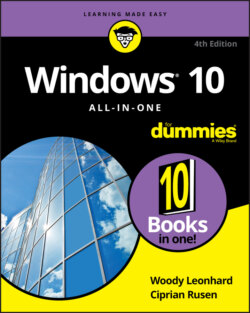Читать книгу Windows 10 All-in-One For Dummies - Ciprian Adrian Rusen, Woody Leonhard - Страница 8
Introduction
ОглавлениеWindows has a long and glorious history, stretching all the way back to Windows 1.0 in 1985. It was sent to the bit bucket in the sky at the end of 2001. Windows 3.0, starting in 1990, began to fill Microsoft’s coffers and 3.1 (1992) is widely held as a landmark achievement in the history of computing. Then came Windows NT — a completely new beast, built to be a server — and the reunification of consumer and server side in Windows 95 (Chicago), Windows 98 (Memphis — the first version to ship with Internet Explorer built-in), 2000, and the much-maligned Windows ME.
With Windows XP (Whistler) in 2001, Microsoft took on the mantle of juggernaut, and blew away everything in its path. Also in 2001, the US Department of Justice sued Microsoft for using its monopoly power to roll over other Internet browsers. Such was the staying power of Windows XP that it was used in a significant number of PCs for many years after its launch.
Windows Vista came along in 2006/2007, but it was upstaged in 2009 by Windows 7 — arguably the most-loved version of Windows. It continues to capture a large share of Windows users and was only recently upstaged by Windows 10.
Then, in 2012, there was Windows 8. Think of Windows 8/8.1 as an extended, bad, no-good, horrible nightmare. Microsoft’s woken up now. They fired almost everybody who ran the Windows 8 operation, cleaned out the house, and brought in some truly gifted engineers. Windows 10 is a brand-new day. Whether it’s your brand-new day is another story.
Windows 10, released in July 2015, looks a little bit like Windows 7 and a little bit like Windows 8.1. It doesn’t work like either of them, but for the billion-and-a-half Windows users out there, at least it’s recognizable as Windows.
If you haven’t yet taken the plunge with Windows 10, I advise you to go slowly. Microsoft is furiously working on extending the product and shoring up problems. The Windows 10 you know today will change in a few months — a new version appears every six months — and you may like the new one better. Before installing Windows 10, I would simply count to ten.
For most Windows 8 and 8.1 users, Windows 10 is a no-brainer. You can kvetch about some problems — the disappearance of Windows Media Center, for example. There are dozens of additional details, but by and large, Windows 10 is what Windows 8.1 should’ve been.
Windows 7 users did not have as much incentive to move to Windows 10, but there are some good changes. Microsoft effectively ditched Internet Explorer and built a much lighter and more capable browser called Microsoft Edge. Instead of desktop gadgets, which in Windows 7 were held together with baling wire and chewing gum, Windows 10 sports an entire infrastructure for apps (also known as Universal apps). Windows 10 works with all the new hardware, touchscreens, and pens. There’s an improved Task Manager, File Explorer, Clipboard, and a dozen other system utilities.
Is that enough to convince Windows 7 users to abandon ship in droves? Probably not. The single biggest allure of Windows 10 for the Windows 7 battle-hardened is that it’s clearly the way of the future. Also, since January 2020, Windows 7 no longer receives updates and security patches. That’s a major risk for users who want to stay safe on the Internet.
If you want a better Windows, for whatever reason, you’ll have to go through Windows 10.
Here’s what you should ask yourself before you move from Windows 7 to Windows 10:
Are you willing to learn a new operating system, with a number of new features that may or may not appeal to you?
Are you willing to let Microsoft snoop on your actions, more than they did with Windows 7? Microsoft has become more transparent about what it being snooped, and it appears to be roughly on par with Google’s snooping and arguably less intrusive than Apple’s snooping.
Are you willing to let Microsoft take control of your machine? The company has already shown that it can take Windows 7 and 8.1 machines to town, with the Get Windows 10 campaign. But in Windows 10, it’s considerably more difficult to keep patches at bay.
Are you willing to ditch a trusted operating system (Windows 7) that is no longer secure because Microsoft has decided to stop supporting it, and deal with Windows 10’s annoyance factors for the sake of security?
This isn’t the manual Microsoft forgot. This is the manual Microsoft wouldn’t dare print. I won’t feed you the Microsoft party line or make excuses for pieces of Windows 10 that just don’t work: Some of it is junk, some of it is evolving, and some of it is devolving. My job is to take you through the most important parts of Windows 10, give you tips that may or may not involve Microsoft products, point out the rough spots, and guide you around the disasters. Frankly, there are some biggies.
I also look at using non-Microsoft products in a Windows way: iPhones, Androids, Kindles, Gmail and Google apps, Facebook, Twitter, Dropbox, Firefox, Google Chrome, iCloud, and many more. Even though Microsoft competes with just about every one of those products, each has a place in your computing arsenal and ties into Windows 10 in important ways.
I’ll save you more than enough money to pay for the book several times over, keep you from pulling out a whole shock of hair, lead you to dozens if not hundreds of “Aha!” moments, and keep you awake in the process. Guaranteed.
